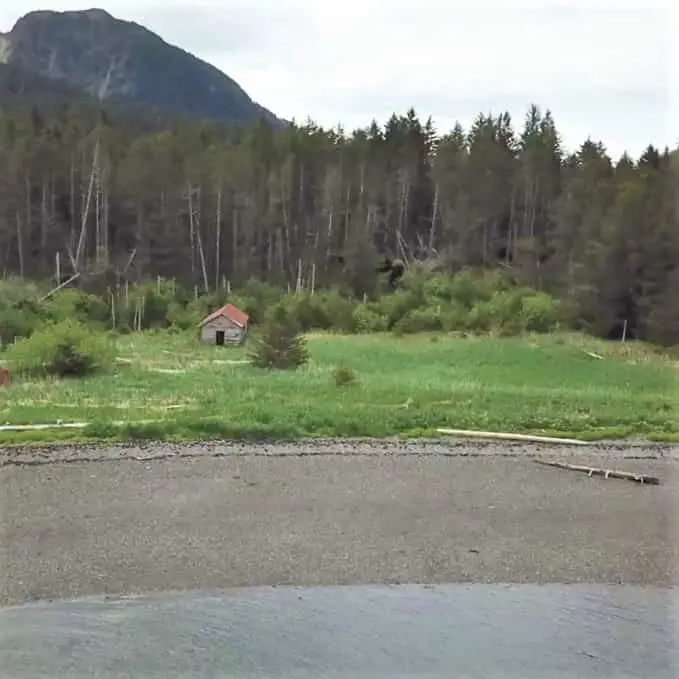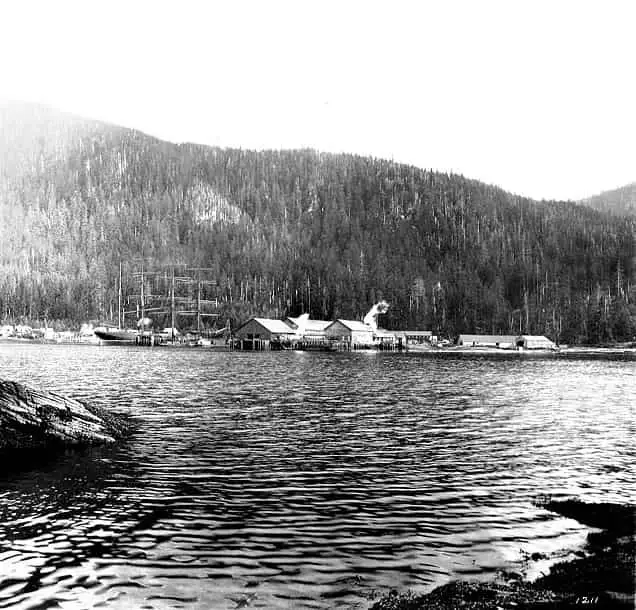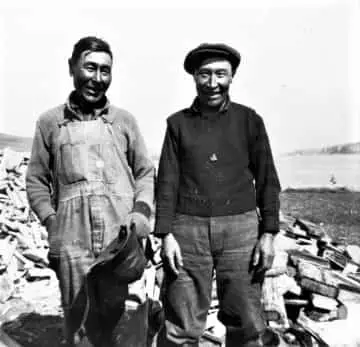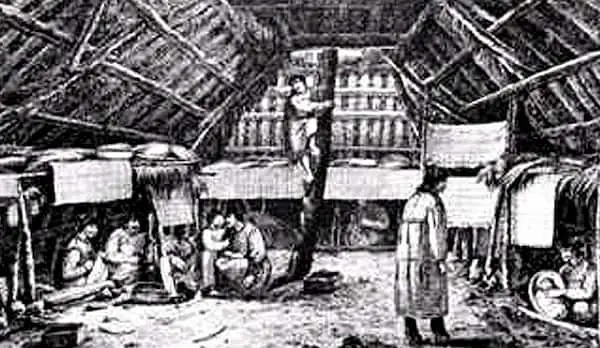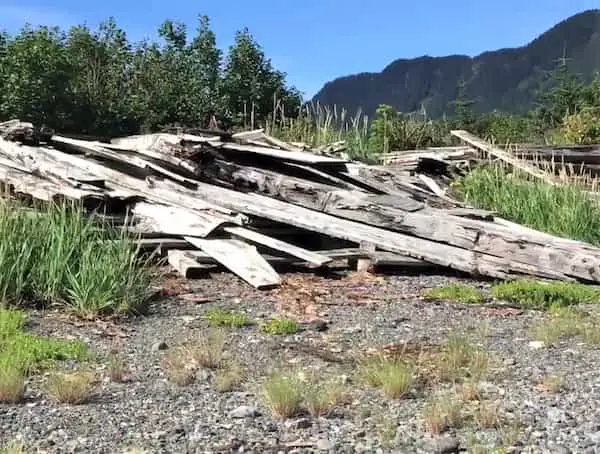The Enigma of Port Chatham: Uncovering a Century of Mountain Terror Legends.
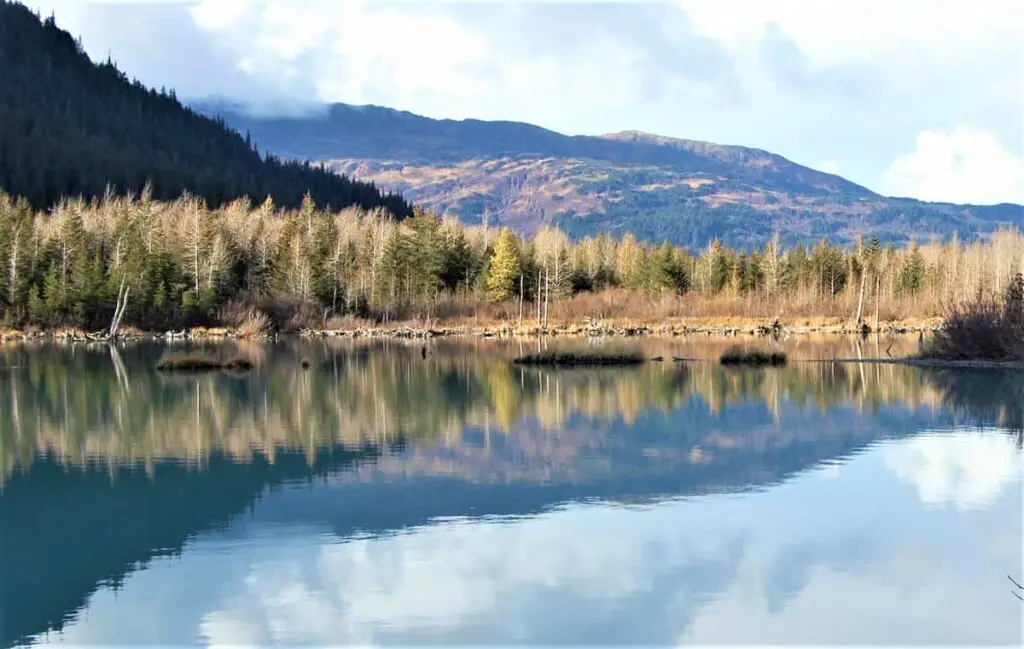
The beautiful town of Port Chatham on the southwestern shores of the Kenai Peninsula, Alaska, USA. Was it abandoned overnight because it was haunted?
You might wonder how something could ever be this beautiful… Coming in through the opening of the Bay of Port Chatham in the sunlight, a warm summer day, The green mountains surrounding the grey gravel shores. The dark, almost black water mirroring white clouds, every now and then shadowed by a huge bald eagle searching the untouched nature for its prey.
Still, if you sense an undetermined dread, a sudden feeling of disturbance as if you were observed by someone… Or something. Then, you’re not alone. Because this is one of the scariest spots on the American continent.
And the villagers’ sudden escape from the once small but prosperous settlement, is one of the greatest mysteries in the history of Alaska.
A short history.
In 1786 a British ship sought refuge in Chatham Bay during a storm. The Captain’s name was Nathaniel Portlock of the Royal Navy, and that name was later given to the cannery plant on the southern shores. But it would take more than a hundred years before anything else than wilderness was to be seen here.
After the US bought Alaska from the Russians in 1867 southerners started to come to the new land for hunting and gold mining opportunities. In late 1800 small villages started to pop up around the fishing industry. And especially on the Kenai peninsula the canneries, cold store and smoking facilities were the main business activity.
In 1912 a cannery opened in Port Graham some 15 miles away on the northern side of the tip of the Kenai peninsula. In 1915 a cod and halibut cold storage plant was built in Port Chatham. A chrome mine opened opposite the inlet, in Chrome Bay, two years later. A small settlement started to grow, around mining, fishing, and fish processing. In 1921 it even got a Post office, and soon it felt almost like a real town.
In 1928, a small salmon cannery was opened in Portlock/Port Chatham, and two years later, in 1930, a bigger cannery was built by the A. N. Nilson Company. For a few decades, these plants offered a stable income for a handful of people. Because we’re talking about a small place, even by Alaska’s standards.
The famous Port Chatham horror.
But something wasn’t right. Some sinister entity, in and around the Bay, started to show its presence to the villagers. It began right when the first settlers got there, but it became more and more difficult to ignore it as years went by. Most of the workforce in the facilities were of Russian-Alutiiq extraction. And they already had an idea about what was lurking in the forests…
What they referred to is a big hairy Bigfoot-like creature that walks on two legs, much bigger and stronger than a human. From being a silent threat, only to those who venture too far into the wild at night, the sightings became more frequent … And closer.
And when people started to disappear and die, the villagers finally abandoned Port Chatham more or less overnight. Leaving their homes, and livelihoods behind. The last man to leave was the Postmaster. In 1951 he locked the door to the local post office, never to return again.
Here is a list of what happened in Port Chatham in the first half of the 20th century.
- Andrew Kamluck was murdered in 1931. Someone, or something, hit him over the head with a piece of heavy log-moving equipment. The piece of machinery was found more than 10 feet away from the body, and it was too heavy for one man to lift, let alone swing it and strike a standing man.
- Around the same time, a gold miner went to his claim never to return. According to the Port Graham elder, Simeon Kvasnikoff, no traces were ever found of him, nor at his cabin, nor anywhere else. It was as if he had disappeared from the surface of the earth.
- Tom Larsen, a local sawmill owner, was out chopping wood for fish traps, when he spotted a big hairy creature on two legs on the shore. He ran to his cabin to get his gun. When he came back, the creature was just standing there, looking at him, without running away or charging him. Larsen could never explain why he didn’t fire his rifle at it.
- During WW2 the workers of the Cannery plant often went into the forest to hunt, never to come back. Some bodies were later found mutilated and dismembered in a way that no animal would or could do.
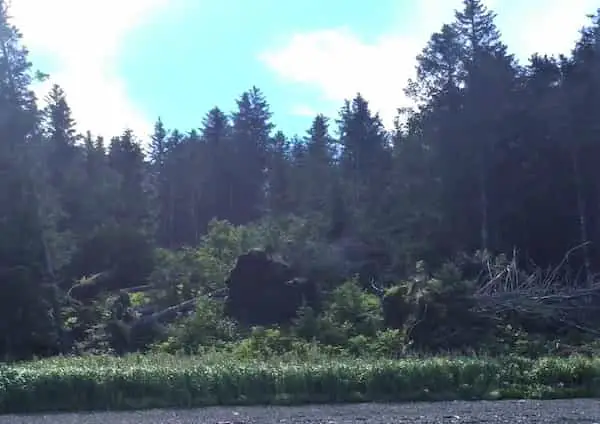 In the 40s a group of hunters were tracking a moose. On the path, they found 18 inches long footprints They concluded that something else was stalking the animal other than them. At a certain point, they found an opening and signs of a fight. The only prints moving away from the site were the 18-inch footprints they had seen earlier. It was as if the unknown predator had killed the moose, an animal of at least 500 pounds, possibly 1000, and carried it away, on its shoulders.
In the 40s a group of hunters were tracking a moose. On the path, they found 18 inches long footprints They concluded that something else was stalking the animal other than them. At a certain point, they found an opening and signs of a fight. The only prints moving away from the site were the 18-inch footprints they had seen earlier. It was as if the unknown predator had killed the moose, an animal of at least 500 pounds, possibly 1000, and carried it away, on its shoulders. - In 1973, three hunters took shelter in Port Chatham during a three-day storm and claimed that each night something walked around their tent on what sounded like only two feet.
- In 1905, the workers of the cannery refused to go back to work, as they were afraid of the hairy man haunting the neighborhood. Only when the manager of the plant hired armed guards to watch not only the fish cannery but also the village, did they agree to come back to work.
- Trees were being pulled up with the roots for no apparent reason. Sometimes they were put back upside down, with the roots pointing upward.
So, where’s the truth in all this?
Was Port Chatham really haunted? What was it that frightened a whole community to such an extent that they preferred to leave their home and just run? Was it a Sasquatch, a Bigfoot, or was it something even more sinister?
Let’s look at the facts. Because this is not New York, London, or L A… It’s Alaska, a huge, desolate State with wildlife, harsh weather and nature, and generally difficult living conditions. People who go missing aren’t all that unusual. It’s twice as common in Alaska as elsewhere in the USA. And big bears can be mistaken for many things.
This poor bear walks on its back legs because the front paws are injured. You can see the right front paw being contorted (1.02). Scientists say bears can walk reasonably well on two legs.
But let’s look at the evidence one by one.
The first issue: The sudden escape.
The town was abandoned in the late 40s or the early 50s depending somewhat on who claims it. The post office was closed in 1951, that’s reasonably verified. Now, Portlock/Port Chatham isn’t the only abandoned village in Alaska. There are at least 50 small towns just like this one, some say more than 100, in the northernmost State.
Alaska’s history is a chain of entrepreneurship, dreams, prosperity, and failure. Many came up north to set up businesses and start a new career. Some succeeded, while others didn’t.
Fishing was a big industry, but after the war, the ships became bigger, and the need for local storage and refining slowly became obsolete. The boats cooked, canned, and stored the catch directly on the ship. The cold facilities and canneries that took the hardest blow were the small ones… Like Port Chatham.
- A. N. Nilson Company, the owners of the Portlock Cannery, started a second plant in Seattle’s Ballard area in 1950. Closer to the market and easier to manage.
- The mine at Chrome Bay was very active during WW2, but immediately after, the demand for chrome dropped drastically, and the mine closed.
In this context, it’s not difficult to see why people moved away from Port Chatham to bigger urban centers like Nanwalek, and Port Graham. And I haven’t found anything to suggest that the migration was hasty or unplanned.
The second issue: The hauntings.
Some of the testimonies are obviously exaggerated or simply wrong:
The workers of the cannery that demanded armed guards back in 1905 is a strange statement. In 1905 there was no cannery in Port Chatham. There were fishers and hunters, but no big, single employer to whom you could possibly direct any demands. It sounds strange.
There were many more testimonies of people who went missing, as well as people who were killed by something. But, as said before, this is Alaska. People go missing every day. More than 2000 disappear every year in Alaska. Many of which are never found again. And people get assassinated. I can’t find it extraordinary that a gold miner is killed at his claim… Especially if there was gold in it.
It is also true that there are other abandoned towns in Alaska. Many of them have their own stories, their own hauntings, and some even had their inhabitants fleeing “overnight”.
What do the locals say?
Well, while some locals say that Bigfoot/Sasquatch is very real, others deem it as a hoax. The opinion here is divided… For or against, Yes or no. Even though no evidence has ever been presented as proof of an actual specimen, many people, especially among those who are familiar with the big open forests, swear they exist.
It has also been suggested that the thing or things that haunted Port Chatham was supernatural… A paranormal phenomenon. This is a less popular explanation though.
… And the experts, what do they say?
As the creature of Port Chatham often is regarded as physical and natural, no investigation of paranormal activity has ever been done. And the investigations of Bigfoot creatures around the bay are not very serious, to say the least. A few youtubers, a pseudo-exploratory full-length movie, and a local radio show, that’s all.
And we don’t have any documentation… None at all. No photos, no videos, not even reliable police reports. All we have are stories.
Rests the single fact that the town, or towns were abandoned… Maybe suddenly, overnight, but more likely. over some time. This fact alone is actually a very important part of the history. Abandoned settlements are not uncommon in Alaska, and it’s a fact that both the mine and the cannery closed before and around 1950. Still, the escape isn’t perfectly natural or 100% motivated…
Alaska after WW2.
Because it’s not entirely true that everything died out with the closing mine and fish cannery. Fishing for the King Crabb started to generate massive incomes in Alaska in the 50s. And in the 60s oil started to become big business. Especially the Cook Inlet filled up with new oil rigs. So it wasn’t like everybody shut down and moved out.
Many moved to the bigger centers, more for practical reasons. And that was obviously part of a more general transfer of people from the countryside to the cities. Something that happened more or less all over the planet, after the war. But Port Chatham lying right in the middle of the new opportunities seized to exist in a very short time… The plants closed, but why was the transfer so definite, and so complete?
Because there is more…
The last piece of the puzzle is connected to the Alutiiq, or the Sugpiaq, as they are sometimes called. The natives of western Alaska.
To the Alutiit, the whole area around Port Chatham has a bad aura. Just the fact that they have a name for the dreaded hairy beast that runs the forests, and watch sawmill owners from the shoreline. He’s called the Nantiinaq. And he’s not like the average Bigfoot, a shy forest man who does everything to stay as far away from people as possible. An overgrown Gorilla, who is dangerous only if you get too close and you stalk it.
No, the Nantiinaq is a deadly predator. A monster who kills people for no obvious reason, just to tear their limbs apart. A creature that actively hunts humans… An enormous, hideous murderer, bigger than a Grizzly and meaner than a Wolverine.
There is a bit of confusion about the names of the settlements in the bay. Some say that Port Chatham and Portlock were two different settlements, built very close. The cannery was called Portlock, and so were their products. I would refer to the town as Port Chatham, and the plant as Portlock. Anyway, it’s probably correct to imagine one single village next to the cannery.
There were two more villages in the bay, though. Alutiiq-villages… Axu’layik, and To’qakvik. The Alutiit had winter- and summer quarters, and at least Axu’layik was a winter settlement. As such the houses were built for permanent living, dug down, and planked on top. The natives’ houses were small but warm and functional. They were well built and fit to withstand the harsh environment and keep the people inside alive.
The Alutiit weren’t depending on the employment from the cannery and the mine, in the same way, that the Euro-Americans were. They had a different relationship with the land, and they wouldn’t be as soon to leave as the Southerners.
Still, they left. Axu’layik as well as To’qakvik were abandoned just like Port Chatham, and it seems to have happened around the same time. I think it would take more substantial motifs to leave your home than just to leave the place where you work… To run away from where you were born, where you grew up, where you met your first love, and where you were supposed to give up your breath in the end, that’s a much more difficult decision.
Nanwalek elder Malania Helen Kehl, who was born in Port Chatham in 1934 explained in an interview: “
– My parents, along with the rest of the village, grew weary of being terrorized by a creature the Alutiiq called a Nantiinaq, meaning half-man, half-beast…many of the residents refused to venture into the surrounding forests, and over time, abandoned their homes and the village school, and moved…
Conclusion
I believe it’s plausible that many people would leave a small settlement because there are no more jobs. I think it’s possible that Port Chatham was abandoned because the small industry closed. These things happen all the time. Opportunities arise, and then the production stops, and people move away again. It’s not unusual or particular in any way.
But when the natives suddenly left their hometown… Now, that is much more difficult to explain. And if all these people, natives and not, moved away in a very short period of time, then that one fact could be a sign that something wasn’t right in Port Chatham… That someone or something forced them away rather than the transfer being just something they did to find new jobs and more prosperity.
I can’t say I’m convinced that Bigfoot exists, but I am convinced that something happened in Port Chatham… Something other than an industry shutting down.
Exactly what it was that caused them to move out, has never been confirmed. But the supposedly evil creatures have never been debunked either. And they could still be out there… Waiting…
Someone ought to investigate the area around the bay for evidence of the Nantiinaq. But do it seriously… For real.
Until then, I’d say that there is definitely a possibility, that something is haunting the forests around the abandoned town of Port Chatham.

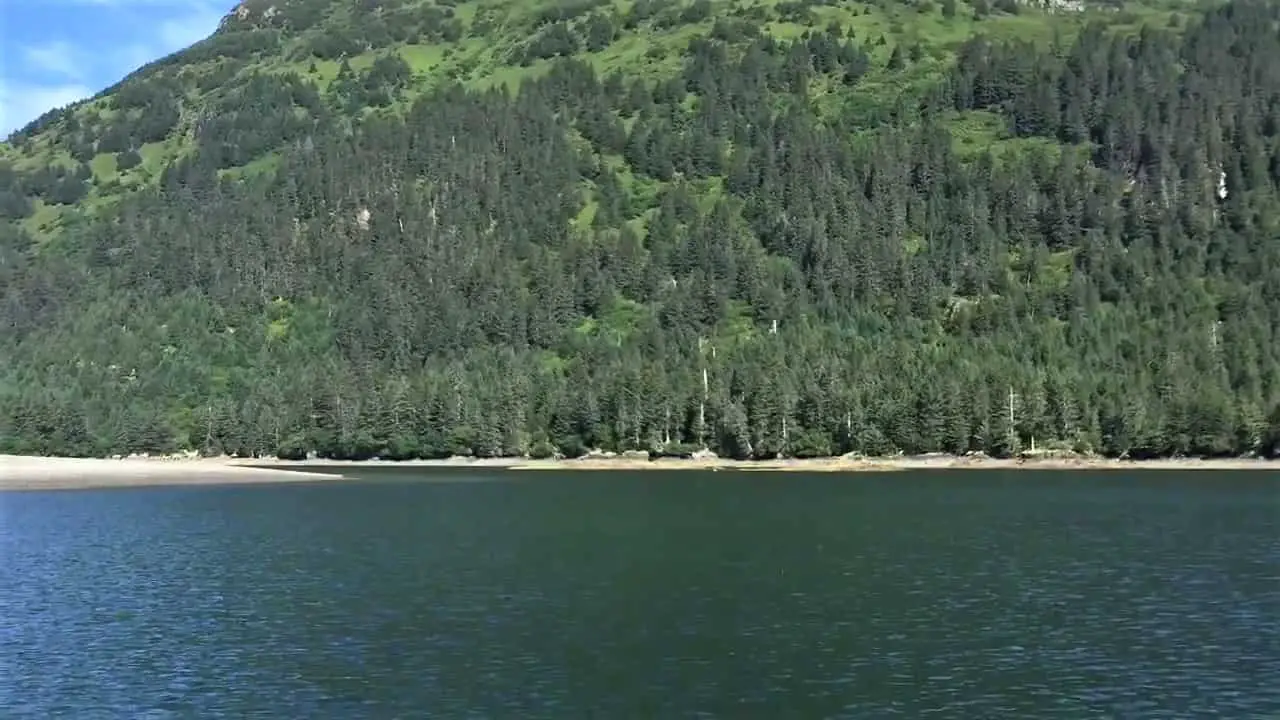
sources
- Alaska’s Digital Archives
- The Mouth of the Kenei / Haunting memories — ‘Nantiinaq’ sightings, spirits led to desertion of Native village
- United States Senate / Tariff Act of 1921
- Kenai Fjords / Historic Resource study
- Crosscut / Julia Child’s play
- The Seattle Times / Erling Nilson, 81, made smoked fish popular delicacy
- Alaska Historical Society / Alaska Canneries
- Alaskool / The People
- Wikipedia


